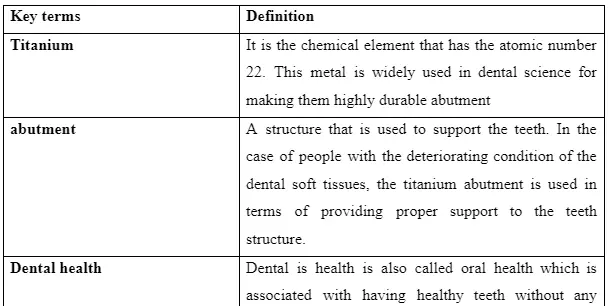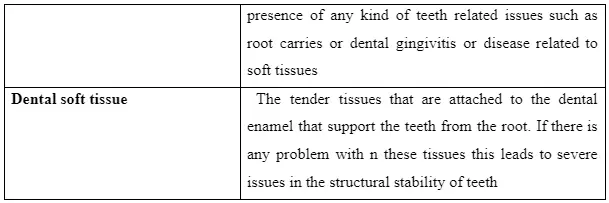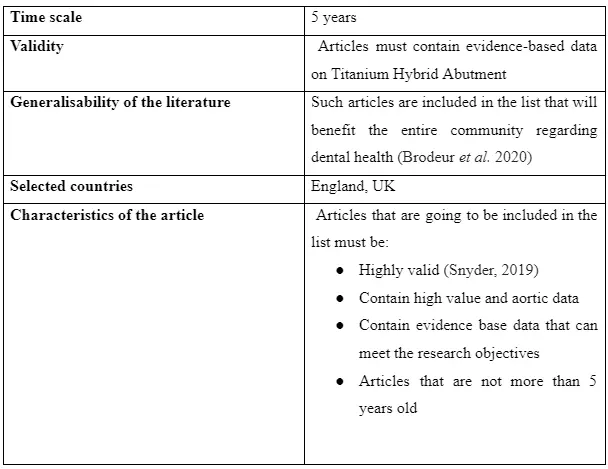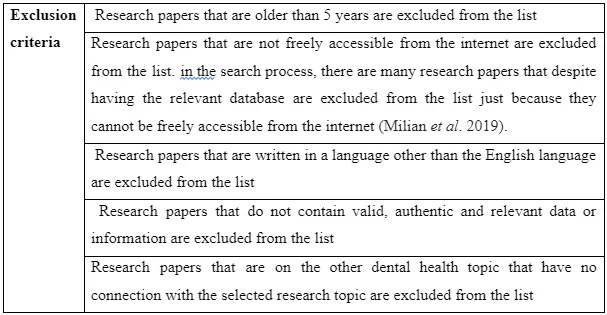Database Analysis for Titanium Hybrid Abutment Literature
Method:
Search strategy:
As mentioned by Oztemel and Gursev (2020), the research method is the pathway that is used by the researcher for the collection of the relevant research paper. This research paper has used the secondary research method in which the relevant online databases are used in terms of collecting the relevant research papers on titanium hybrid abutment. including data analysis dissertation help. As argued by Snyder (2019) before using any particular research method researcher must check that whether the particular research method is highly relevant to collect the appropriate database. This study has used the relevant clinical online databases that are associated with collecting the relevant research papers. Here CINAHL, PubMed, Cochrane Library (Central Register of Controlled Trials) and PsycINFO via OVID are used to collect the relevant articles on titanium hybrid abutment. Here researcher has used the key terms that have been used for searching the relevant articles that can assist this research study to collect high-value research papers. The key terms are highly useful in selecting the relevant research paper that can assist the researcher to meet the research objectives. British, National Index (BNI) has also been used in their research study to collect the relevant research paper but after searching the paper it was seen that majority of the research paper do not contain the relevant information and most of the papers are repeated. This is why the search through the BNI has been removed. Following key terms are used by the researcher to collect the appropriate research paper:

Key terms:


Boolean operator:
The researcher has also used the Boolean logic AND OR in terms of narrowing the literature search. as mentioned by (0, while using effective methods of literature search researcher needs to use the Boolean operator for narrowing the search results thereby selecting only the articles that are highly relevant to research objectives as well as research aims. Here researcher has used the following Boolean chain
Titanium * AND Titanium abutment * OR zirconia * AND Clinical outcomes *, OR *barriers AND facilitators OR Bio-competitive OR Time and cost AND Titanium Hybrid Abutment
Inclusion and exclusion or articles:
Inclusion criteria:
This study has used the inclusion and exclusion criteria to select highly valid articles and exclude irrelevant articles. As mentioned by Snyder (2019), inclusion criteria are the parameters that are used by researchers for selecting the highly valid and high-value research papers that can assist the researchers to meet the research objectives. In this research, the study researcher has used the inclusion criteria to select such articles that can meet the research outcomes and research objectives for the relevant information regarding the usefulness and drawback of using the Titanium Hybrid Abutment. Here 5-year times scale has been set to select the relevant articles. the research paper that is published within the 5 years is collected from the online database for this research study. the validity and authenticity of each research paper have been checked before including the research paper into selection the list, the research papers that do not contain the high value and authentic data regarding the research topic are excluded from the list. As mentioned by Brodeur et al. (2020), validity is an important parameter while searching for a relevant research paper that can assist the researcher to maintain the authority and trustworthiness of the research study. here some other dental topics such as root caries, dental health, oral health hygiene, gingivitis and the dental recession are also using to collect the sufficient number of research papers. These topics are useful in collecting authentic research papers otherwise the search result shows the insufficient number of research papers that can interfere with the generalisability of this research study. as mentioned by Milian et al. (2019), the generalizability of a research study is the aspects in which the research study benefits the entire community instead of providing beneficence to the particular groups in the society. The UK has been set as the target country for selecting the research paper, the researcher has collected most of the article base on England which will provide the researcher with information regarding the dental processes that are used in England. following is the table of the inclusion criteria:
Inclusion criteria

Exclusion criteria:
As mentioned by Milian et al. (2019), in any research study exclusion criteria are used to narrow the literature search. In this research study, the exclusion criteria are used by the researcher to narrow the selected list of articles thereby selecting only authentic and appropriate articles that would be highly relevant to the research topic. exclusion criteria that are used by the researcher are as follows:

Search result:
Take a deeper dive into Critical Analysis of Real Time Associations with our additional resources.
By the exclusion and inclusion criteria, this study has selected a total of 7 research papers that are highly relevant to the research topic. The research papers that are selected for the research study are screened to check the validity and authenticity of each research paper. Here researcher has checked whether selected articles are relevant to meet the research objectives. Finally, different themes have been identified from the research articles some themes are identified from the selected research papers, which are dental health, titanium hybrid abutment, usefulness and drawback of titanium hybrid abutment, use of zirconia hybrid abutment and clinical outcomes.
Analysis; (using CASP tool)
critical appraisal skill programme (CASP) is the tool that is widely used by researchers in terms of analysing the validity and authenticity of the content of selected research papers. CASP is the most effective and trustworthy tool in the research study that contains a checklist in which there are many analysing criteria for different types of research. In this study, the CASP tool is to be used to critically appraise the selected articles.
Nouh et al. (2019) have used a qualitative study that has been performed in the laboratory. As per the CASP checklist for the qualitative study, while analysing any research paper, the first thing that researcher needs to check is whether the research paper has a clear aim and objectives. Nouh et al. (2019) have mentioned a clear aim in their study which presents a comparative analysis of hybrid‐abutment‐crowns and the hybrid‐abutments with the separate crown. In this research paper, anthers have discussed the clear aim which highlights the main objectives of the research paper. This research papers aim to provide new insight on the usefulness of using the titanium-hybrid‐abutment‐crowns over the hybrid abutments with the separate crown.
Ongun et al. (2018) have mentioned the clear aim in their study which is to analyse the mechanical and the chemical properties of the titanium-infiltrated ceramic-network material for providing strength and stability to dental soft tissues. This study has mentioned the research objectives that prioritise the analysis of the usefulness of titanium-infiltrated ceramic-network material in terms of supporting the structure of molar and premolar dental structure. This study mentioned the use of titanium and zirconia abutment material can be used in the soft tissues of the teeth to provide the stability as well as support to the entire teeth structure. As mentioned by Elsayed et al. (2018), while critically analysing any research paper researcher must ensure that the relevance of the research aim and objectives have been checked in relation to the current research topic. In this context, although the research paper written by Ongun et al. (2018) is able to present a clear aim and objectives there is a lack of emphasis on the selected research topic.
Design (2019) has presented a clear and relevant research aim as well as research objectives that are highly appropriate to the selected research topic. Based on the CASP checklist, it can be stated that the research paper, by Design (2019) is able to present such aim and research objective that reflects the entire research topic. This study aims to discuss the biochemical behaviour of titanium implants which can influence the stability, strength and supporting nature of the abutment. This paper also presents another clear aim to discuss the drawbacks as well as limitations of using titanium abutment and zirconium crown for providing support to the dental structure.
on the other hand, the research paper by written Elsayed et al. (2018) fails to present the clear aim and research objectives that interfere with the CASP tool criteria. Through reading the entire content of the research paper it is seen that this article aims to discuss the clinical outcomes and health implications of the zirconia implant abutments. Pitta et al. (2020) are able to meet the first checklist criteria of the CASP tool, in which it has presented the clear aim and research objectives. This research paper aims to analyse the technical outcomes and mechanical stability f the zirconium and titanium abutment to provide proper strength as well as stability to dental soft tissues. On the other hand, this paper also highlights the aim which prioritises the drawback as well as benefits that are associated with the use of the titanium abutment over the zirconium abutment in terms of preventing further root caries and other dental health issues in patients.
Both the research papers Güth et al. (2021) and Ioannidis et al. (2020) bot have mentioned the clear aim and objectives. The research paper is written by Güth et al. (2021) the study aims to analyse the usefulness of using the 3y-TPZ zirconia crowns in case of the titanium implants. On the other hand, in the other research paper, Ioannidis et al. (2020) aim to discuss the usefulness of using implant-supported CAD/CAM crowns in titanium abutments. Therefore, both the articles are able to meet the CASP tool first criteria which ensure the validity of their aims and research objectives.
The second CASP tool criteria for the secondary research paper is to check whether the research paper has made it clear discussion the used methodology. As mentioned by Long et al. (2020), while critically analysing any research paper researcher must ensure that the research paper has a clear and concise research method that follow all necessary pathways of a research study in terms of meeting the research aim. Based on the CASP cyclist, while analysing the authenticity of a research methodology, the researcher needs to analyse whether the research paper is able to present a clear search strategy, data collection process, types of data collection and final results, in the research paper, Ongun et al. (2018) have presented the clear secondary research methods which consist of the clear search process, the data collection methods and the data analysis process. In this research, paper author has selected the secondary articles to collect relevant database. This research paper has used the key term and Boolean operators in selecting the relevant research papers.
Design (2019) and Elsayed et al. (2018) both have presented secondary research methods which are not clearly discussed. Here researchers do not mention the clear process in collecting the database. Although both the secondary research paper is unable to present the clear research methodology by analysing the entire contents of these research paper, it is clear that these papers have used the exclusion and incusing criteria in selecting the relevant research papers on the selected topic and then use the Boolean operation to narrow the literature search. On the other hand, Güth et al. (2021) and Ioannidis et al. (2020) are able to present clear research methodology in which authors presented the clear search strategy, the clear data collection and the literature search.
The third criterion of the CASP tool is the appropriate research design. As mentioned, by Pérez-Rojo et al. (2018), while it comes to analyse a research paper, research needs to check that whether research paper uses the right as well as relevant research design that can meet the research objectives. Among the selected research papers Nouh et al. (2019), Ongun et al. (2018), Elsayed et al. (2018) and Design (2019) have motioned the clear research design in the research paper. Nouh et al. (2019) have used the explanatory research design that is useful in discussing the biochemical behaviour of titanium and zirconium in relation to providing stability and structural strength to the teeth. As argued that Long et al. (2020), on critically analysing any research paper, along with analysing the clarity of the research design, research needs to check the relevance of the used research design to the research topic. In this context, the explanatory research design is highly relevant to the research objective and the research aims set by Design (2019). The other articles Nouh et al. (2019), Ongun et al. (2018), Elsayed et al. (2018) also use the explanatory research design that is highly used for presenting a clear discussion on the benefits and the limitations of using the zirconium metal in the titanium implant. Pitta et al. (2020) are unable to present any clear discussion on which research design has been used over here to meet the research objectives and the research aim. In this context, it can be stated that this research paper is unable to meet the CASP tool criteria. On the other hand, although Pitta et al. (2020) do not mention any clear discussion on the research design, by reading the entire content it is understood that researchers have used the explanatory and deductive research approach over here. The explanatory and the deductive research approaches are highly relevant to the research study which enables Pitta et al. (2020) to use the existing theories that are associated with analysing the technical as well as mechanical stability of zirconium and titanium abutment in term of providing the strength ad stability to the teeth structure.
The fourth and fifth CASP criteria are the usefulness of the data findings and data analysis. As mentioned by (), while analysing any secondary research paper, researcher needs to check the relevance of the themes that are presented in the systematic review. Nouh et al. (2019), Ongun et al. (2018) and Elsayed et al. (2018) have identified themes such as hybrid‐abutment‐crowns, hybrid‐abutments with the separate crown, Titanium -infiltrated ceramic-network, biochemical behaviour of titanium and zirconium and Implant-Supported CAD/CAM Crowns in the Titanium Abutments. In these research papers, the authors have presented an evidence-based discussion that analyses the different aspects of the Titanium Hybrid Abutment. Here Elsayed et al. (2018) mention that although there is the wide usage of the Titanium Hybrid Abutment in dental science. Dental practitioners need to maintain a high level of safety and health measures while using this process. As compared to the polymer-infiltrated ceramic network, Titanium abutment has higher chances of causing enamel and soft tissues damage if not properly fit the dental structure by the dental practitioners. Ongun et al. (2018) mentioned in this aspect that although 95% of the dental cases, dental practitioners use the titanium abutment to provide structural stability to enamel and soft tissues. There are high chances of soft tissue infection and surgical infection if clients do not follow the safety guidelines for at least 15 days after the implantation of the titanium abutment. As argued by (0, while checking the validity of the data analysis of any research paper researcher needs to check whether the research paper has used the relevant evidence to support the user data that are presented in the research paper. Both the the Güth et al. (2021) and Ioannidis et al. (2020) have used the evidence-based discussion regarding the usefulness of using the 3Y-TZP zirconia crowns in the titanium implants into dental structure.

Results:
Based above-mentioned critical analysis of the selected literature it can be stated that, although there are many criticisms regarding the usage of the zirconia crowns in the Titanium implant, in more than 95% of dental cases dental practitioners use Titanium Hybrid Abutment for providing stability t with the dental structure. Some adverse clonal outcomes are associated with poor implants of titanium abutment such as surgical infection, gingivitis and dental recession. On the other hand, the cost of using the Titanium Hybrid Abutment is higher than using other metallic implants which can be a major barrier for people in choosing titanium impacts. Above all these limitations, titanium provides the highest strength to the dental structure than any others metal implants. If proper clinical processes are followed for effective implantation, then the durability of the titanium is higher than other elements which make the patients free from any kind of infections and health issues.
Reference list:
Brodeur, A., Gray, D.M., Islam, A. and Bhuiyan, S., 2020. A Literature Review of the Economics of COVID-19.
Design, D.I.A., 2019. Influence of ceramic materials on biomechanical behavior of implant supported fixed prosthesis with hybrid abutment. European Journal of Prosthodontics and Restorative Dentistry, 27, pp.1-7.
Elsayed, A., Wille, S., Al‐Akhali, M. and Kern, M., 2018. Effect of fatigue loading on the fracture strength and failure mode of lithium disilicate and zirconia implant abutments. Clinical oral implants research, 29(1), pp.20-27.
Güth, J.F., Schweiger, J., Graf, T., Stimmelmayr, M., Schubert, O. and Erdelt, K., 2021. In vitro pilot study: Are monolithic 3Y-TZP zirconia crowns too strong for titanium Implants?. The International Journal of Prosthodontics.
Ioannidis, A., Gil, A., Hämmerle, C.H., Jung, R.E., Zinelis, S., Eliades, G. and Hämmerle, C.H., 2020. Effect of Thermomechanical Loading on the Cementation Interface of Implant-Supported CAD/CAM Crowns Luted to Titanium Abutments. The International Journal of Prosthodontics, 33(6), pp.656-662.
Jayachandran, S., Hill, K. and Walmsley, A.D., 2021. A critical review of qualitative research publications in dental implants from 2006 to 2020. Clinical Oral Implants Research.
Long, H.A., French, D.P. and Brooks, J.M., 2020. Optimising the value of the critical appraisal skills programme (CASP) tool for quality appraisal in qualitative evidence synthesis. Research Methods in Medicine & Health Sciences, 1(1), pp.31-42.
Long, H.A., French, D.P. and Brooks, J.M., 2020. Optimising the value of the critical appraisal skills programme (CASP) tool for quality appraisal in qualitative evidence synthesis. Research Methods in Medicine & Health Sciences, 1(1), pp.31-42.
Milian, E.Z., Spinola, M.D.M. and de Carvalho, M.M., 2019. Fintechs: A literature review and research agenda. Electronic Commerce Research and Applications, 34, p.100833.
Naidoo, N., Ravaud, P., Young, B., Amiel, P., Schanté, D., Clarke, M. and Boutron, I., 2020. The research burden of randomized controlled trial participation: a systematic thematic synthesis of qualitative evidence. BMC medicine, 18(1), pp.1-11.
Nouh, I., Kern, M., Sabet, A.E., Aboelfadl, A.K., Hamdy, A.M. and Chaar, M.S., 2019. Mechanical behavior of posterior all‐ceramic hybrid‐abutment‐crowns versus hybrid‐abutments with separate crowns—A laboratory study. Clinical oral implants research, 30(1), pp.90-98.
Ongun, S., Kurtulmus-Yilmaz, S., Meriç, G. and Ulusoy, M., 2018. A comparative study on the mechanical properties of a polymer-infiltrated ceramic-network material used for the fabrication of hybrid abutment. Materials, 11(9), p.1681.
Oztemel, E. and Gursev, S., 2020. Literature review of Industry 4.0 and related technologies. Journal of Intelligent Manufacturing, 31(1), pp.127-182.
Pérez-Rojo, G., Martín, N., Noriega, C. and López, J., 2018. Psychometric properties of the CASP-12 in a Spanish older community dwelling sample. Aging & mental health, 22(5), pp.700-708.
Pitta, J., Hjerppe, J., Burkhardt, F., Fehmer, V., Mojon, P. and Sailer, I., 2020. Mechanical stability and technical outcomes of monolithic CAD/CAM fabricated abutment‐crowns supported by titanium bases: an in vitro study. Clinical Oral Implants Research.
Snyder, H., 2019. Literature review as a research methodology: An overview and guidelines. Journal of Business Research, 104, pp.333-339.
Dig deeper into Cultural Diversity in Global Business with our selection of articles.
- 24/7 Customer Support
- 100% Customer Satisfaction
- No Privacy Violation
- Quick Services
- Subject Experts



